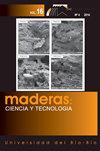Preliminary evaluation of the incorporation of cellulose nanofibers as reinforcement in waterborne wood coatings
IF 1.5
4区 农林科学
Q3 MATERIALS SCIENCE, PAPER & WOOD
引用次数: 0
Abstract
The wood is exposed to possible damages caused by weather, requiring the application of a finishing coat to provide extra protection. The aim of this work was to evaluate the influence of the addition of microfibrillated cellulose in waterborne varnish on the colorimetric parameters, wettability and finish characteristics of wood products. Color was evaluated with a CM-5 spectrophotometer; surface wettability was analyzed by contact angle measurement using a drop shape analysis goniometer; and abrasion, adhesion and impact tests were performed to evaluate the quality of the coating. The coating’s optical characteristics were not affected by the addition of microfibrillated cellulose. The changes in wood wettability were small, with no statistical difference between the wood treated with plain varnish and that with unbleached microfibrillated cellulose. In the analysis of the variation of the contact angle during the elapsed time, the coating containing unbleached microfibrillated cellulose presented the best results. The results of finish quality did not show numerical changes after the addition of the microfibrillated cellulose, but qualitatively the microfibrillated cellulose caused better anchoring of the coating to the specimens. Therefore, the use of microfibrillated cellu - lose as reinforcement in coatings has potential, but tests with different consistencies and tests of other proper - ties are necessary.纤维素纳米纤维掺入增强水性木器涂料的初步评价
木材暴露在可能由天气造成的损坏中,需要应用面漆来提供额外的保护。本研究的目的是评价水性清漆中添加微纤化纤维素对木制品的比色参数、润湿性和光洁度特性的影响。用CM-5分光光度计评价颜色;用水滴形分析角仪测量接触角,分析表面润湿性;并对涂层进行了磨损、附着力和冲击试验,以评价涂层的质量。微纤化纤维素的加入不影响涂层的光学特性。木材润湿性的变化很小,用普通清漆处理的木材和未漂白的微纤化纤维素处理的木材之间没有统计学差异。在分析接触角随时间变化的过程中,未漂白微纤化纤维素涂层表现出最好的效果。添加微纤化纤维素后,涂层的表面质量在数值上没有变化,但在定性上,微纤化纤维素使涂层对试样有更好的锚定作用。因此,使用微纤化纤维素作为涂层的增强材料是有潜力的,但还需要进行不同浓度的测试和其他性能的测试。
本文章由计算机程序翻译,如有差异,请以英文原文为准。
求助全文
约1分钟内获得全文
求助全文
来源期刊

Maderas-ciencia Y Tecnologia
工程技术-材料科学:纸与木材
CiteScore
2.60
自引率
13.30%
发文量
33
审稿时长
>12 weeks
期刊介绍:
Maderas-Cienc Tecnol publishes inedits and original research articles in Spanish and English. The contributions for their publication should be unpublished and the journal is reserved all the rights of reproduction of the content of the same ones. All the articles are subjected to evaluation to the Publishing Committee or external consultants. At least two reviewers under double blind system. Previous acceptance of the Publishing Committee, summaries of thesis of Magíster and Doctorate are also published, technical opinions, revision of books and reports of congresses, related with the Science and the Technology of the Wood. The journal have not articles processing and submission charges.
 求助内容:
求助内容: 应助结果提醒方式:
应助结果提醒方式:


